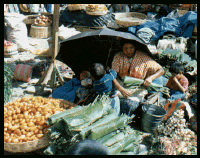General Information
- Home Page
- Spanish Schools
- Tours & Treks
- Guide Books
- Discussion Forums
- Dance Schools
- Volunteering
- Spanish e-Courses
- Bookstores
- Restaurants
- Real Estate
- Laundry
- Weaving School
- Night Life
- Business Directory
- Newspapers & TV
- Get Paid to Travel
- Banks & Travel Insurance
- Bus, Planes & Autos
- Internet & Telephone
- Map of Xela
- Driving to Guatemala
- Rural Spanish Schools
Hotel - Guesthouses
Medical Tourism
Popular Guide Books
Travel Insurance
Volunteering in Xela
| Tweet |
Mayan Village of Almolonga, Guatemala
 Located about 20 minutes by bus from Quetzaltenango. Almolonga provides medicinal sulfur baths, an up close look at every day agro-business with a taste of Guatemalan culture.
Located about 20 minutes by bus from Quetzaltenango. Almolonga provides medicinal sulfur baths, an up close look at every day agro-business with a taste of Guatemalan culture.
Almolonga is well know in Guatemala as the Garden of the Americas. Most of the vegetables are grown on small family plots and there is something growing in Almolonga year round.
Market Day: Wednesday & Saturday
The mineral baths of Almolonga are a favorite of the Indigenous Mayan people. Some have individual rooms with large tubs where a whole family can bath in hot water piped in from a local spring. Others are large communal pools where many people bath together.
Not far from Almolonga you will find Las Fuentes Georginas a wonder set of natural pools fed by a spring of hot water, naturally heated by the volcano. The Fuentes as they are known locally is a wonderful spot to relax and soak for a few hours. They offer hikes, a restaurant, changing rooms, showers...etc.
A HISTORY OF ALMOLONGA, FROM WHERE THE WATER SPRINGS
The name Almolonga is derived from the Nahualtl; alt = agua (water), molo = forma (forms), short for moloni = manar la fuente (the spring flows), signifying “lugar donde mana o brota el agua”, or “place from where the water springs forth”, due to the thermal springs that bountifully exist in the area. Heated by Volcan Santiaguito, and carried to the region by underground passageways, the waters are utilized by the local population for medicinal bathing. People from all over Guatemala come to Almolonga for the quality of the baths.
During the Spanish period, the town was known as San Pedro Almolonga, the official name as it appeared in the old “Kingdom of Guatemala” Index. In 1524, by order of Cortes, Spaniards under the command of Pedro Alvarado invaded the area south of Mexico. There they encountered a very large population of Kiche and Cakchikeles indigenous groups, members of a civilization similar to their northern brethren.
In the past the town was also known by the name Sakpolia o Molonya, that meant “place where the water streams out”, for abundant brooks and springs located in the area. This name appears in the 18th century title to Casa Ixquin – Nehaib, owned by Señora Otzoya.
The oral tradition indicates that before the arrival of the Spanish the indigenous communities of the high plains would go down to the coast to harvest maiz and other products, farms that the Spanish called “Estancia”. During the 16th century, many townspeople were removed from their land and organized into other communities. It is thought that the population of Almolonga originally lived around Xetutul.
Foundation: Almolonga, though unofficially existing long before the arrival of the Spanish, was added to the city boundaries of Quetzaltenango on the 27th of August, 1839. Doing so put Alomolonga under modern Guatemalan judicial and administrative control.
Until 1960, Almolonga had only one village, called “Los Baños”. Nevertheless it was elevated to the status of town on July 11th of that year, the nucleus of which was called “Choq’ antel”, actually called “Las Delicias”. In an agreement with the government on November 29th, 1962, the area was designated a “zona hidrografica”.
Almolonga is famous for the productivity of its people and quality of its crops, which are sold all over Central America. The confluence of water sources in the area provides for some of the most fertile farmland in Central America. Many of the crops sold in Xela come from Almolonga. The waters of Almolonga fortify your food, your body and your soul
Travel Insurance. Simple & Flexible.
Our Sponsors
Places of Interest
- San Pedro La Laguna
- San Marcos La Laguna
- Lake Atitlan
- Antigua
- Tikal Tours
- Chichicastenango
- San Marcos, San Marcos
- Livingston
- Local Festival Dates
- Rural Spanish Schools
- Las Fuentes Georginas
- Zunil
- Almolonga Gardens
- Volcanoes
- Get Paid to Travel!!
- Local Markets
- Huehuetenango
- Laguna Chicabal
- Nearby Beaches
- Takalik Abaj Ruins
- San Calos Sija
- IRTRA - Waterslide Park
- Weather in Xela
- Spanish E-courses




